 |
Classic plugs and sockets made by Dutch companies |
| Only a few companies in the Netherlands
have been active in producing electrical accessories for domestic use.
Import of
plugs and sockets made in Germany and other European countries have
always
dominated the Dutch market. When the use of Bakelite came to an end in the 1960s it was no longer profitable for Dutch companies to switch to new thermosetting polymers for domestic plug production. Material, made by Dutch companies in the 1930s - '70s, is shown below. Companies are listed in alphabetical order. Click a logo for more company details. At the bottom of the page you will find a summary of plug types nowadays used in the Netherlands. |
 |
 |
 |
 |
| 1 | Early
1950s model of plug and connector, both rated at 6A - 250V. Partially
split pins had a diameter of 4.0 mm. {WN} |
| 2,
3 |
Plug and connector rated 10A - 250V. Plug has 4.8 mm solid pins. {WN} |
| 4 | Plug rated at 10A - 250V. It is the only model of the shown Corodex plugs that has a KEMA certification mark. {WN} |
 |
5 Neoprene appliance cord with moulded Schuko plug and DIN 49491 appliance connector. Rating: 10A - 250V. Cord length: 84 cm. Drakaflex appliance and extension cords for domestic use have been made from the 1950s until '70s. {RH} |
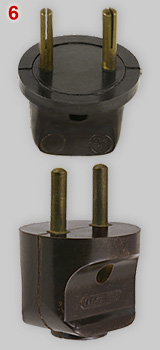 |
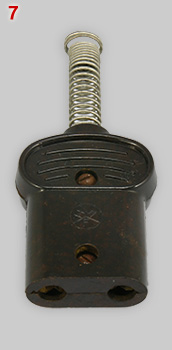 |
 |
 |
| 6 | Top:
1930s
plug rated at 6A - 250V with 4.0 mm partially split pins. Bottom: plug with solid 4.8 mm pins, but still rated at 6A - 250V. Probably a 1950s model. {WN} |
| 7 | Not earthed appliance connector plug rated at 10A - 250V. {WN} |
| 8,
9 |
Four pole socket and matching plug. The 4.0 mm pins are arranged in a square with 11 mm sides. This non-polarized pin orientation means that there are four positions in which the plug can be inserted in the socket. The intended application of plug and socket is unknown. Socket has a KEMA certification mark. {WN} |
 |
Hazemeyer Hengelo In 1906 F. Hazemeyer & Co. started in Hengelo production of cast-iron middle voltage electrical appliances. Bakelite (named Hajaliet) press facilities were introduced in 1930. Bakelite was among others used for production of domestic plugs and sockets. The production of low voltage electrical accessories has been discontinued in the 1960s. Classic HH three-phase plugs are shown in the museum heavy duty section. |
 |
 |
 |
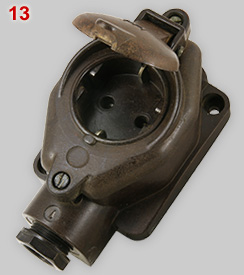 |
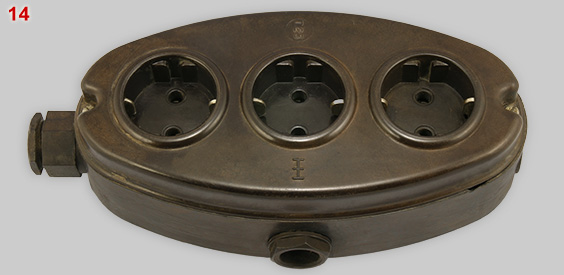 |
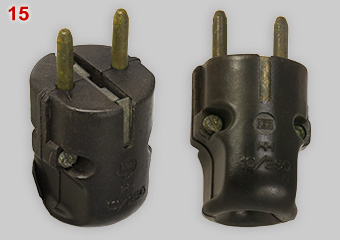 |
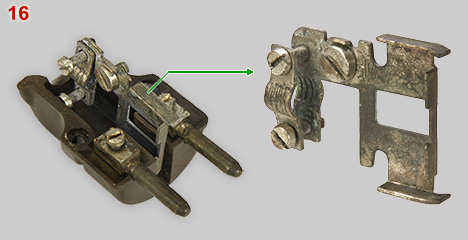 |
| 10, 12 |
Non-earthed surface mount socket with
switch, rated at 6A - 250V. Image No. 12 shows the socket interior. Right: the single pole rotary switch. Left: socket with high quality connectors. A spring (see green arrow in inset) pushes a plug pin firmly to the opposite metal part of the contact. Each of the Hazemeyer plugs, sockets, switch and components shown on this page have a rectangular KEMA mark that was introduced in the early 1950s. {WN} |
| 11 | Non-earthed plug rated at 10A - 250V. Plug has 4.8 mm solid pins. {WN} |
| 13 | Schuko surface mount socket with cap.
Rating: 10A - 250V. {WN} |
| 14 | Schuko surface mount triple socket, rated at 10A - 250V. Single, dual and triple surface mount sockets are listed in the 1938 Hazemeyer catalog, including the shown Type 23. A 15A dual socket is shown on the classic Schuko page. |
| 15, 16 |
Schuko
plug rated at 10A - 250V.
The earth clip (image No. 16) is a remarkably sturdy and quite unique
design. Dating: a similar plug is mentioned in a 1938 Hazemeyer
catalog. The model shown is probably a 1950s or 60s version.
{WN}. |
| Hollandse
Apparaten Fabriek (now ABB
Electrification in Ede) and Hazemeyer Hengelo (now Eaton Holec) are
still active electro-technical companies, but production of domestic
plugs and
sockets ceased many decades ago. However another product, distribution
boards, made by both HAF and HH,can still be
found in many
Dutch
homes. An example of a classic distribution board is shown on a
separate page. |
 |
Inventum
Huishoudelijke Apparaten Founded in 1908 in Bilthoven. Production started with electrical household appliances as toasters, kettles, irons (see image elsewhere). From the late 1920s until '60s (?) necessary plugs and extension cords were made also. |
 |
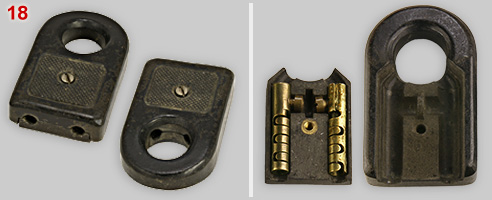 |
 |
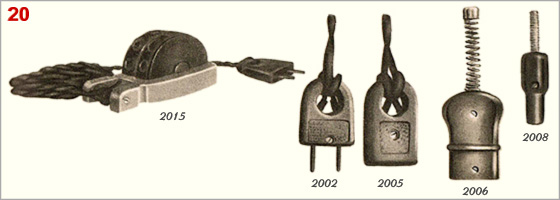 |
| 17 | Ebonite
multi-outlet for five flat - or three round base - plugs, mounted on a
wooden base. |
| 18 | Connector plug with large grip that offers the possibility to wrap cord around the grip to fasten the extension cord (see plugs 2002 and 2005 in image 20). It is an alternative to an internal cord grip that is used in the other plugs shown on this page. {WN} |
| 19 | Not earthed appliance connector plug for irons, toasters etc. with 6 mm inlet pins. Rating: 10A - 250V. {WN} |
| 20 | Images taken from a 1932 Inventum catalog
showing multi-outlet 17, connector plug 18 and appliance connector plug
19. |
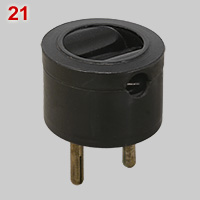 |
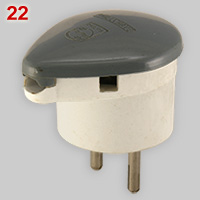 |
 |
 |
| 21 | Plug
with side cord entry, rated at 6A - 250V. It has an MPAD mark with
company code 58, which referred to Deutsche Philips GmbH in Berlin. A
German (Bakelite) MPAD registration does not exclude the possibility
that the plug has been made in the Netherlands. Duroplast press work
made by NV Philips Industrie in Hasselt, Belgium had MPAD code ZH. |
| 22,
23 |
Plug of a Philishave
razor with switch for 110-130 Volt or 180-220 Volt.
The two colour duroplast plug was introduced in 1960 for a new series
of
razors. {WN} |
| 24 | Polarized,
not earthed, neoprene appliance connector, rated at 6A- 250V. Spacing
of contacts is 10 mm (center to center). Plug - not an IEC 60320 model - has type number BB6782. The plug was used to power the Philips cassette recorder types N2205 (1968-'70) and N2209 (1971-'76). The recorders used direct current, provided by a transformer or by batteries*. The transformer converts 220V AC first to a lower voltage, then to DC and stabilized the output at 9.6 Volt DC, which corresponds to the voltage given by a set of six 1.6V batteries**. However, because the transformer was built-in, rather than external, a polarized plug was not strictly essential. * Information given by Jean Lorteije, Museum of Philips Historical Products, Eindhoven. ** Information given by Werner Hepp. |
 |
Plugs
permitted
in the Netherlands from 1984 The use of the following types of domestic plugs is allowed: • CEE 7/4 (Schuko) plugs; fit in both types of sockets. • Round base CEE 7/2 plugs that fit not in earthed sockets. This feature goes back to an old safety rule that unearthed plugs may not fit in earthed sockets. The other way round was allowed. • CEE 7/17 plug, also known as contour plug because its shape follows the inner outline of a Schuko socket and the earth pin of 'French' sockets. CEE 7/17 could replace round base 16A plugs, but rewireable contour plugs are not allowed in the Netherlands. • CEE 7/16 (Euro-type) plugs. Initially only non-rewireable plugs were allowed, but nowadays also rewireable models are on sale. Perilex sockets and plugs are still used for electric ranges, because they are less bulky than IEC 60309 (CEE 17). Furthermore: IEC 60430 appliance couplers, and - for replacement only - "classic type" DIN 49491 connector plugs. |
 |
KEMA
certification marks Dutch certification marks are issued by the Keuring van Elektrotechnische Materialen, founded in 1927 in Arnhem. The circular mark with triangles - rare on plugs - has been replaced by the rectangular model about 1950. KEMA was taken over by Det Norske Veritas in 2011, but KEMA certificates are still issued. |
| |
D i g i t a l M u s e u m o f | |
P l u g s a n d S o c k e t s | |



